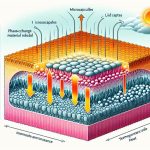Imagine your clothing acting like a chameleon, adjusting to its surroundings to keep you comfortable. This is the promise of phase-change materials (PCMs) in smart fabrics. By absorbing and releasing heat, PCMs manage temperature fluctuations, ensuring you stay warm when it's cold and cool when it's hot. These materials undergo a fascinating process that involves shifting between solid and liquid states, a principle rooted in thermodynamics. Curious about how this science is revolutionizing textiles? There's a lot more to uncover about how PCMs are shaping the future of clothing.
Table of Contents
Key Takeaways
- PCMs absorb and release heat during phase transitions, enabling temperature regulation in smart fabrics.
- Smart fabrics with PCMs adapt dynamically to body heat, enhancing wearer comfort and performance.
- Types of PCMs include organic, inorganic, eutectic, and microencapsulated, each with unique properties.
- NASA's integration of PCMs in the 1980s pioneered their use in modern textiles.
- PCMs in textiles act as thermal batteries, efficiently storing and releasing heat for stable temperature maintenance.
What Are Phase-Change Materials?
Phase-change materials (PCMs) are substances that absorb and release thermal energy during the process of melting and freezing. When you explore the world of thermal regulation and material science, you'll find that PCMs play a fundamental role in managing temperature fluctuations. These materials can store and release heat efficiently, making them invaluable in applications where maintaining a stable temperature is essential.
Imagine a scenario where you're dealing with fabrics designed for extreme conditions. PCMs embedded in these textiles can absorb excess heat when the surroundings are too hot and release that stored heat when it gets cold. This dynamic response not only enhances comfort but also optimizes energy use. By tailoring the thermal properties of materials, you can create smart fabrics that adapt to environmental changes seamlessly.
In material science, understanding the thermodynamic properties of PCMs allows you to manipulate their phase-change points precisely. This knowledge lets you engineer materials that meet specific thermal regulation requirements. Whether you're focusing on personal comfort or industrial applications, mastering the science behind PCMs gives you a powerful tool to innovate and excel.
With PCMs, you don't just react to temperature changes; you control them.
History of PCMs in Textiles
The integration of PCMs into textiles dates back to the 1980s when NASA pioneered their use to manage the temperature of astronaut suits. This groundbreaking application was one of the earliest steps in the evolution of fabrics. NASA's innovation provided a foundation for the development of smart fabrics that could regulate temperature, ensuring the comfort and safety of astronauts in the harsh environment of space.
As time progressed, the use of PCMs evolved from space missions to everyday applications. By the 1990s, the sportswear and outdoor gear industries began to recognize the potential of these innovative textiles. The ability to incorporate phase-change materials into fabrics meant that athletes and adventurers could maintain ideal body temperatures regardless of external conditions. This was a significant leap in the evolution of fabrics, making them more functional and adaptive.
Today, PCMs are seamlessly integrated into a variety of textiles, from high-performance athletic gear to everyday clothing. The continuous innovation in this field has led to more versatile and efficient materials, pushing the boundaries of what fabrics can achieve.
This historical journey underscores the transformative power of PCMs in redefining the textile industry.
How PCMs Work
Understanding how PCMs work requires a look at their unique ability to absorb, store, and release thermal energy. When the temperature around you rises, these materials absorb excess thermal energy, causing them to melt. This phase change from solid to liquid enables PCMs to store thermal energy effectively. As temperatures drop, the PCMs solidify, releasing the stored thermal energy back into the environment.
You can think of PCMs as thermal batteries. They charge by absorbing heat and discharge by releasing it, ensuring efficient temperature regulation. This mechanism helps maintain consistent temperatures, making smart fabrics highly effective in managing body heat. When you wear clothing embedded with PCMs, the material actively responds to your body's thermal changes, absorbing heat when you're too warm and releasing it when you're cold.
Mastering this concept allows you to appreciate the sophistication behind smart fabrics. These fabrics don't just passively insulate; they dynamically interact with your body's thermal energy, enhancing comfort and performance. Understanding the science of PCMs gives you an edge in selecting the best smart fabrics for various applications, from outdoor gear to everyday wear.
Types of PCMs
You'll find various types of PCMs, each tailored to specific temperature ranges and applications. Organic PCMs, such as paraffins and fatty acids, offer excellent thermal regulation due to their high latent heat storage. They're particularly useful in garments designed for moderate temperature fluctuations.
Inorganic PCMs, like salt hydrates, excel in energy efficiency, making them ideal for applications requiring rapid heat absorption and release. These materials are often employed in high-performance sportswear where quick thermal response is essential.
Eutectic PCMs combine organic and inorganic elements to achieve a balanced performance. They offer the dual benefits of high latent heat and rapid thermal regulation, making them versatile. For instance, eutectic PCMs are frequently used in medical textiles where maintaining a stable temperature is crucial for patient comfort.
Microencapsulated PCMs are another innovative type. By encapsulating PCMs in a protective shell, they enhance the fabric's durability without compromising its thermal properties. You'll find these in everyday wear, offering consistent thermal regulation and extending the garment's lifespan.
Understanding these types of PCMs allows you to select the right material tailored to your specific needs, ensuring ideal thermal regulation and energy efficiency in your smart fabrics.
Benefits of Smart Fabrics
Choosing the right kind of PCM is just one of the many benefits smart fabrics offer in enhancing comfort and functionality. You'll discover that smart fabrics excel in regulating body temperature, which directly impacts your comfort and performance. By incorporating phase-change materials, these fabrics absorb, store, and release heat, keeping you at an ideal temperature regardless of external conditions.
From an environmental impact perspective, smart fabrics are a game-changer. They contribute to energy savings by reducing the need for additional heating or cooling systems. This not only lowers your carbon footprint but also translates to cost efficiency. Imagine the energy savings you'll achieve by wearing a garment that naturally adjusts to temperature fluctuations, reducing the need for external climate control.
Furthermore, smart fabrics are designed for long-term use, reducing the frequency of replacements. This durability further enhances their cost efficiency and minimizes waste, making them a sustainable choice.
When you invest in smart fabrics, you're not just purchasing a piece of clothing; you're committing to a smarter, more efficient lifestyle. Essentially, smart fabrics offer a perfect blend of comfort, performance, and sustainability, aligning with the demands of a conscientious, modern world.
Applications in Clothing
Whether you're an athlete or a fashion enthusiast, smart fabrics are revolutionizing the clothing industry with their innovative applications. Imagine performance clothing that adapts to your body temperature, keeping you cool during intense workouts and warm during recovery. This isn't science fiction; it's the reality of phase-change materials (PCMs) integrated into modern wearable technology.
In the domain of fashion trends, designers are leveraging innovation in textiles to create garments that offer both style and functionality. You can now find jackets that adjust their insulation based on external temperatures, making them perfect for unpredictable weather. These smart fabrics don't just enhance comfort; they also contribute to sustainability by reducing the need for multiple layers of clothing.
For athletes, the impact of wearable technology in performance clothing is profound. Phase-change materials help maintain ideal body temperature, enhancing endurance and reducing fatigue. Think about marathon runners or cyclists who can now perform at their peak without the distraction of temperature fluctuations.
Moreover, these innovations aren't limited to sportswear. Everyday clothing, from casual wear to high fashion, is beginning to incorporate smart fabrics, setting new standards for comfort and utility. The future of clothing isn't just about looking good; it's about feeling good too.
Challenges and Limitations
Despite their innovative potential, smart fabrics face several challenges and limitations that need to be addressed.
One of the primary issues is material performance and durability. You need fabrics that can withstand regular wear and tear, washing, and environmental conditions without losing their smart properties. This durability challenge is significant because the real-world application of these materials demands longevity and reliability.
Another hurdle is cost efficiency. Developing phase-change materials and integrating them into textiles is an expensive process. You want your smart fabrics to be affordable, but the high production costs make it difficult to achieve cost efficiency. This financial barrier limits the widespread adoption of smart fabrics in everyday clothing.
Scalability is also a major concern. Producing smart fabrics on a large scale involves complex manufacturing processes that need to be fine-tuned for mass production. You can't overlook the need for uniform quality and performance in large quantities, which adds another layer of complexity. Addressing these scalability issues is vital for making smart fabrics a mainstream choice.
Future of Smart Fabrics
You can expect smart fabrics to feature advanced adaptive clothing technologies that adjust to your needs in real-time. Imagine wearing garments that automatically regulate temperature, offering sustainable thermal management solutions.
These innovations promise to make your daily life more comfortable and efficient.
Advanced Adaptive Clothing Technologies
Revolutionizing the fashion industry, advanced adaptive clothing technologies seamlessly integrate functionality with style. You're not just wearing clothes anymore; you're donning wearable tech that responds to your environment.
Imagine a jacket that can automatically adjust its insulation level based on the temperature, providing you with ideal comfort regardless of the weather. This isn't science fiction—it's the future of fashion.
Climate control is at the core of these textile innovations. Advanced fabrics embedded with phase-change materials can absorb, store, and release heat as needed. This dynamic temperature regulation means you'll stay cool in the summer and warm in the winter without needing multiple layers.
These innovations are setting new standards in the fashion industry, making it possible for your wardrobe to be as smart as your phone.
But it's not just about comfort. Wearable tech in adaptive clothing offers health benefits, too. Sensors can monitor your essential signs and track your physical activity, providing real-time data to help you stay on top of your health.
This level of integration between technology and textiles opens up endless possibilities for what you can achieve with what you wear. Embrace this future, and you'll never look at clothing the same way again.
Sustainable Thermal Management Solutions
Many smart fabrics now feature sustainable thermal management solutions that optimize comfort while reducing environmental impact. By integrating eco-friendly insulation and energy-efficient textiles, you can achieve superior temperature regulation without compromising on your environmental values. These fabrics harness innovative materials that adapt to your body's needs, ensuring that you stay warm in the cold and cool in the heat.
Imagine a jacket that not only keeps you comfortable across varying climates but also reduces your carbon footprint. That's the promise of energy-efficient textiles. They utilize phase-change materials that absorb, store, and release heat as needed, offering dynamic temperature regulation. This means you'll require less additional heating or cooling, lowering your energy consumption.
Innovative materials like recycled fibers and biodegradable polymers are also pivotal in this evolution. They offer the dual benefits of high performance and reduced environmental impact. By opting for these smart fabrics, you're not just investing in personal comfort—you're also contributing to a more sustainable future.
Incorporating these advanced technologies in your wardrobe means you're at the forefront of a movement towards sustainability and innovation. Embrace smart fabrics and experience the future of eco-friendly, high-performance clothing today.
Frequently Asked Questions
How Are Phase-Change Materials Incorporated Into Fabric?
You incorporate phase-change materials into fabric through microencapsulation or coating techniques. These materials enable thermal regulation by absorbing, storing, and releasing heat, ensuring your fabric adapts to temperature changes efficiently and enhances comfort.
What Are the Environmental Impacts of Manufacturing Pcms?
You should consider the environmental impacts of manufacturing PCMs. Evaluate energy consumption, chemical use, and waste production. Opt for sustainable alternatives that reduce carbon footprints, minimize resource depletion, and promote eco-friendly practices in textile innovation.
Are There Any Health Risks Associated With Wearing Pcm-Infused Clothing?
You might wonder about the potential concerns of wearing PCM-infused clothing. Safety measures are in place to guarantee these fabrics are non-toxic and skin-friendly, but always check for certifications to assure your safety.
How Do You Care for and Wash Smart Fabrics With Pcms?
Caring for smart fabrics is like tending to a delicate plant. Follow washing instructions carefully. For fabric maintenance, handle spills promptly and use gentle drying techniques. Always check the label for specific recommendations to guarantee longevity.
What Innovations Are Expected in PCM Technology for Textiles?
You can expect future developments in PCM technology to enhance sustainability and boost wearable technology. Innovators will focus on maximizing comfort while ensuring eco-friendly materials. These advancements aim to redefine how you experience smart fabrics.
- How Does Ring Spun Cotton Affect Garment Fit and Shape Retention? - August 13, 2024
- What Are the Challenges in Producing Ring Spun Cotton? - August 13, 2024
- Is Ring Spun Cotton Suitable for Plus-Size Clothing? - August 13, 2024







